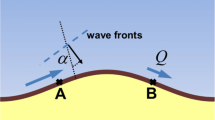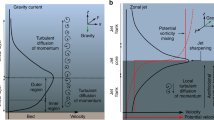Abstract
Alongshore sediment transport that is driven by waves is generally assumed to smooth a coastline. This assumption is valid for small angles between the wave crest lines and the shore, as has been demonstrated in shoreline models1. But when the angle between the waves and the shoreline is sufficiently large, small perturbations to a straight shoreline will grow2,3. Here we use a numerical model to investigate the implications of this instability mechanism for large-scale morphology over long timescales. Our simulations show growth of coastline perturbations that interact with each other to produce large-scale features that resemble various kinds of natural landforms, including the capes and cuspate forelands observed along the Carolina coast of southeastern North America. Wind and wave data from this area support our hypothesis that such an instability mechanism could be responsible for the formation of shoreline features at spatial scales up to hundreds of kilometres and temporal scales up to millennia.




Similar content being viewed by others
References
Komar, P. D. Beach Processes and Sedimentation (Simon & Schuster, Upper Saddle River, New Jersey, 1998).
Zenkovitch, V. P. On the genesis of cuspate spits along lagoon shores. J. Geol. 67, 269–277 (1959).
Wang, J. D. & Le Mehaute, B. in Proc. 17th Coastal Eng. Conf. 1295–1305 (American Society of Civil Engineers, New York, 1980).
Hanson, H. & Kraus, N. C. GENESIS: Generalized Model for Simulating Shoreline Change, Report 1: Technical Reference (US Army Eng. Waterways Experiment Station, Coastal Eng. Res. Cent., Vickburg, Mississippi, 1989).
Le Mehaute, B. & Soldate, M. in Proc. 16th Coastal Eng. Conf. 1163–1179 (American Society of Civil Engineers, New York, 1979).
Fisher, R. L. Cuspate spits of Saint Lawrence Island, Alaska. J. Geol. 63, 133–142 (1955).
Bruun, P. in Proc. 5th Conf. on Coastal Eng. 269–295 (American Society of Civil Engineers, New York, 1954).
Bakker, W. T. A mathematical theory about sandwaves and its applications on the Dutch Wadden Isle of Vlieland. Shore Beach 36, 4–14 (1968).
Sonu, C. J. in Proc. 11th Conf. on Coastal Eng. Vol. 1, 373–400 (American Society of Civil Engineers, New York, 1969).
Verhagen, H. J. Sand waves along the Dutch coast. Coastal Eng. 13, 129–147 (1989).
Thevenot, M. M. & Kraus, N. C. Longshore and sand waves at Southampton Beach, New York: observation and numerical simulation of their movement. Mar. Geol. 126, 249–269 (1995).
Pringle, A. W. Holderness coast erosion and the significance of ords. Earth Surf. Processes Landforms 10, 107–124 (1985).
Inman, D. L. Accretion and erosion waves on beaches. Shore Beach 55, 61–66 (1987).
Stewart, C. J. & Davidson-Arnott, R. G. D. Morphology, formation and migration of longshore sandwaves; Long Point, Lake Erie, Canada. Mar. Geol. 81, 63–77 (1988).
Gulliver, F. P. Cuspate forelands. Geol. Soc. Am. Bull. 7, 399–422 (1896).
Wilson, A. W. G. Cuspate forelands along the Bay of Quinte. J. Geol. 12, 106–132 (1904).
Gilbert, G. K. The topographic features of lake shores. US Geol. Surv. Ann. Rep. 5, 69–123 (1885).
Hoyt, J. H. & Henry, V. J. Origin of capes and shoals along the southeastern coast of the United States. Geol. Soc. Am. Bull. 82, 59–66 (1971).
White, W. A. Drainage symmetry and the Carolina Capes. Geol. Soc. Am. Bull. 77, 223–240 (1966).
US Army Corps of Engineers Wave Information Study at 〈http://bigfoot.wes.army.mil/u003.html〉 (2001).
Moslow, T. F. & Heron, S. D. Holocene depositional history of a microtidal cuspate foreland cape: Cape Lookout, North Carolina. Mar. Geol. 41, 251–270 (1981).
List, J. & Farris, A. F. in Coastal Sediments '99 (eds Drause, N. C. & McLougal, W. G.) 1324–1338 (American Society of Civil Engineers, Long Island, 1999).
Stockdon, H. F., Holman, R. A. & Sallenger, A. H. Longshore variability of the coastal response to extreme storms. Eos 81, F673 (2000).
Tebbens, S. F. & Nelson, E. Wavelet analysis of shoreline change at Cape Hatteras National Seashore. Eos 81, F562 (2000).
McNinch, J. E. & Luettich, R. A. Physical processes around a cuspate foreland headland: implications to the evolution and long-term maintenance of a cape-associated shoal. Continental Shelf Res. 20, 2367–2389 (2000).
Longuet-Higgins, M. S. Longshore currents generated by obliquely incident waves, 1. J. Geophys. Res. 75, 6778–6789 (1970).
Komar, P. D. & Inman, D. L. Longshore sand transport on beaches. J. Geophys. Res. 75, 5914–5927 (1970).
Longuet-Higgins, M. S. in Waves on Beaches and Resulting Sediment Transport (ed. Meyer, R. E.) 373–400 (Academic, New York, 1972).
Deigaard, R., Fredsoe, J. & Hedegaard, I. B. Mathematical model for littoral drift. J. Waterway Port Coast. Ocean Eng. 112, 351–369 (1988).
Acknowledgements
This work was supported by the Andrew W. Mellon Foundation.
Author information
Authors and Affiliations
Rights and permissions
About this article
Cite this article
Ashton, A., Murray, A. & Arnoult, O. Formation of coastline features by large-scale instabilities induced by high-angle waves. Nature 414, 296–300 (2001). https://doi.org/10.1038/35104541
Received:
Accepted:
Issue Date:
DOI: https://doi.org/10.1038/35104541
- Springer Nature Limited
This article is cited by
-
Embayed beach configuration explained by wave sheltering
Scientific Reports (2024)
-
A new approach for incorporating sea-level rise in hybrid 2D/one-line shoreline models
Scientific Reports (2022)
-
Sediment budget of a cuspate shoreline and its influence on spit development—Lagoa dos Patos, Brazil
Geo-Marine Letters (2022)
-
Application of Geospatial Techniques to Determine Coastal Erosion and Accretion along the Ramanathapuram Shore, Tamil Nadu, India
Journal of the Geological Society of India (2022)
-
Interannual sea-level oscillations control on a modern berm-ridges plain in the southern Mediterranean coast, Gulf of Gabes-Tunisia
Journal of Sedimentary Environments (2022)





